North Carolina is a great place to grow shrubs because it has a pretty comfortable climate for most of the year. It doesn’t ever get too far below freezing, or too high above 90, so there are quite a few plants that grow well in the state.

Shrubs are also a great choice for planting as compared to trees or small herbaceous plants. They can be pruned and shaped to make your yard look perfect, or left to grow wild and provide plenty of coverage. Shrubs can be planted in rows to use as a hedge, or planted by themselves to add aesthetic value to a yard. These types of plants are extremely versatile so they are perfect for any gardener. We’re going to walk you through the best shrubs to plant in North Carolina, from flowering to evergreen.
1. Azalea

Azalea flowers add a pop of color to any garden.
©PatGallery/Shutterstock.com
When it comes to flowers, azaleas are a hard shrub to beat. They bloom almost every time of the year (except winter) and do great in a partially shaded location. The best time to plant azaleas in North Carolina is after the last frost of the season, during late winter or early spring.
Azaleas require some of the lowest maintenance for shrubs. They grow fastest when they are young and slow down as they reach full size, which can be anywhere from 2-3 feet for dwarf varieties and up to 20 feet for native azaleas. Most azaleas reach a height of 6 to 10 feet and a width of 5 to 8. The average growth for the shrub is around 2-10 inches per year.
They need to be planted in well-drained dry soil because the roots will root if they stay wet. The name “azalea” actually comes from a Greek word that means “dry” because the plant thrives in dry soil.
One great thing about azaleas is that they are pest-resistant. While most flowering plants are at risk of being eaten by deer and other wildlife, azaleas are not usually eaten by wild animals.
The best place to plant azaleas is under pine trees, if possible. They provide shade for the shrubs and the fallen pine needles add acidity to the soil, which azaleas thrive on. Since North Carolina’s soil is already on the acidic side, azaleas are a perfect plant for the state.
2. Hydrangea
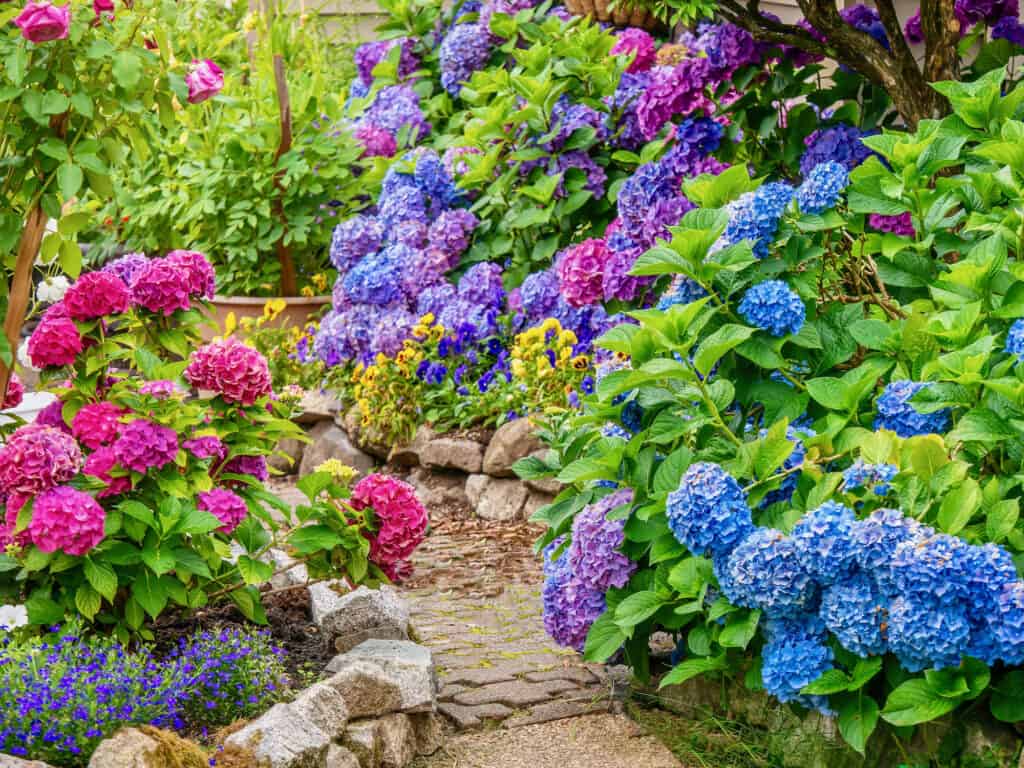
A pretty, lush ornamental garden, filled with bright, colorful hydrangea blossoms in multiple colors.
©iStock.com/Cheryl Ramalho
Hydrangeas are some of the most beautiful and ornamental flowers that you can grow, and they’re pretty easy to maintain. Hydrangeas grow quickly, averaging a growth of 2 feet per year, so plant them in an area with lots of space. At its full size, a hydrangea plant can reach anywhere from 8 to 15 feet tall or more. Make sure the spot you choose for your hydrangea shrub offers plenty of morning and mid-day sun. Hydrangeas need sunlight to flower but prefer a bit of shade in the afternoon.
Hydrangeas can be planted during spring and fall, but make sure to plant them either before or after the frost hits. They can survive through frost and winter temperatures but need time to get established before then.
There are so many cultivars of hydrangea that you could spend hours choosing the perfect plant. Take time to research the different bloom shapes and colors, then choose the variety that you like best for your yard.
3. Aaron’s Beard
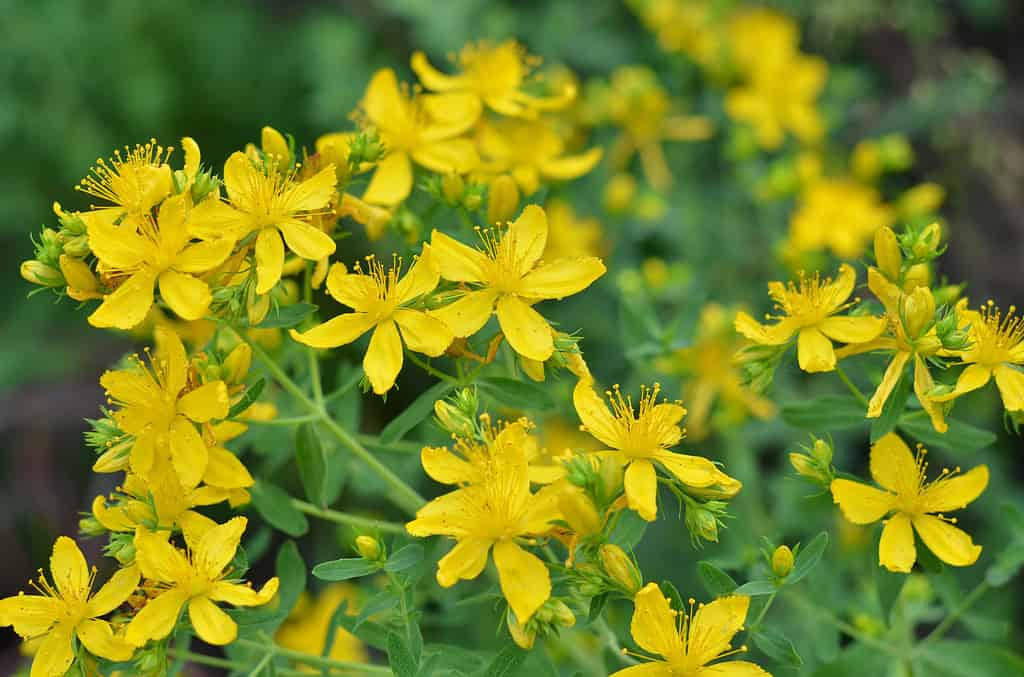
, known as St John’s Wort, is an aromatic perennial herb used in folk medicine.
©Yuliia Bilousova/iStock via Getty Images
Aaron’s beard, or St. John’s Wort, is a great shrub to plant in North Carolina. It produces gorgeous yellow flowers and makes for an excellent ground cover because it’s low growing. It only reaches around 12 to 16 inches tall at its full height. However, it spreads around 2 feet wide and quickly, so it’s great for planting in groups as ground cover.
You can plant St. John’s Wort pretty much any time, but it’s best to plant any new plants in the fall or spring to avoid frost or summer heat. It tolerates many types of soil but does best in well-drained, moist soil. It can be planted in full or partial sun, but if you want to see more blooms you’ll want to plant it in full sun.
4. American Beautyberry
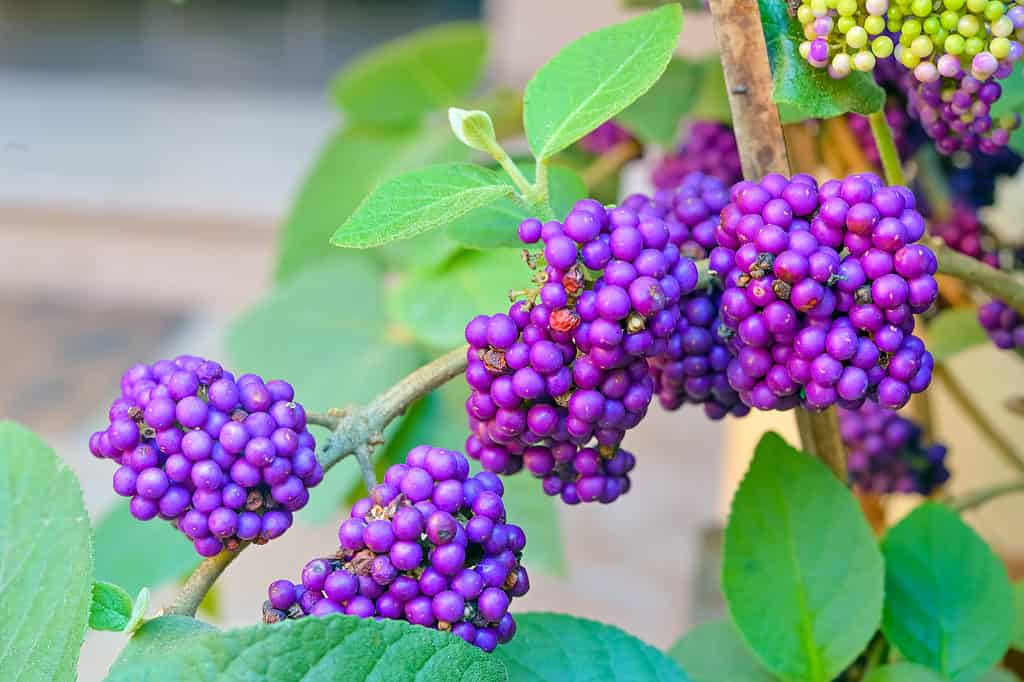
The berries on the beautyberry shrub truly hold up to their name.
©Amvi Jovas/Shutterstock.com
American beautyberry is a beautiful, native shrub that grows extremely well in North Carolina. It produces small, lavender-white flowers during the summer and bright purple berries during the fall. Beautyberry shrubs grow to around 3 to 8 feet tall and 3 to 6 feet wide.
These shrubs prefer partial sun to shade and can tolerate moist and even wet soil during seasonal flooding. They are pretty easy to grow and will provide tons of food for wildlife like birds and small mammals. One unique thing about these shrubs is that they seem to produce more fruit when other beautyberries are planted nearby. This makes them a great choice to plant in groups.
5. Carolina Cherry Laurel

Carolina cherry laurels produce small, white flowers during spring.
©LifeisticAC/Shutterstock.com
While Carolina cherry laurels are technically a type of dense evergreen shrub, some gardeners also consider them to be a type of small tree because of how large they grow. These shrubs can reach heights of 20 to 40 feet. They are very fast growing and often see a growth rate of 25 inches or more per year.
Carolina cherry laurels produce beautiful white flowers during the spring months, usually starting in February. To maximize their growth and production, the shrubs should be planted in full sun, but they can tolerate shade as well. Plant your cherry laurel shrub in moist, well-drained soil but keep in mind that they are drought tolerant once established.
6. Great Laurel
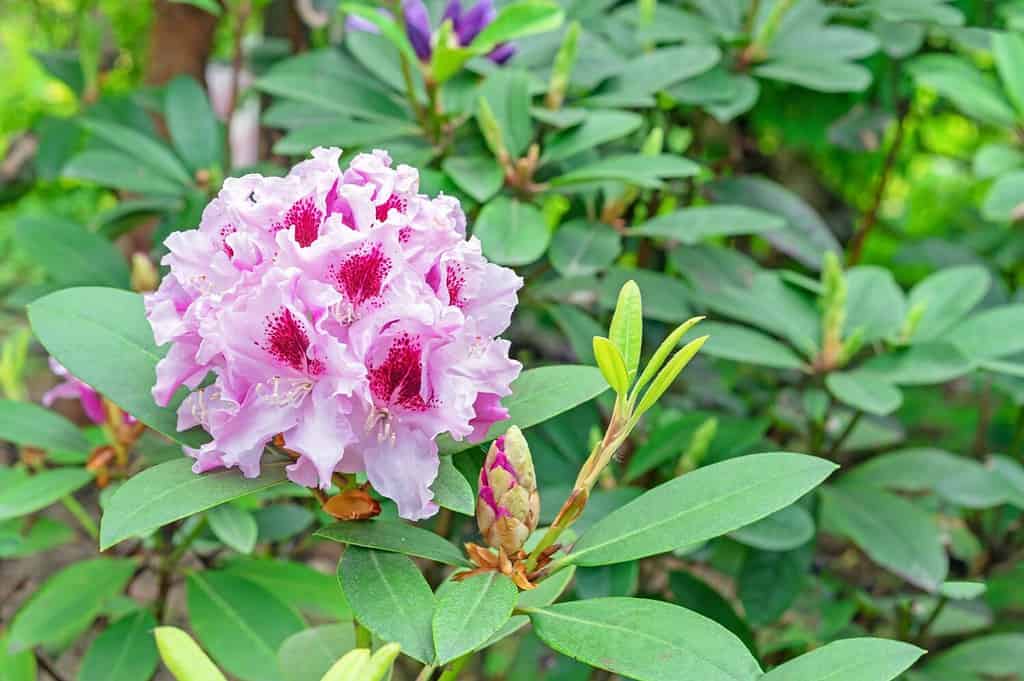
This variety of great laurel produces flowers with a bright pink tint.
©valemaxxx/Shutterstock.com
Despite having a similar name, great laurels actually look a lot different from Carolina cherry laurels. For one, they’re usually smaller, only growing to a height of around 10 to 20 feet. They also produce much larger flowers that can sometimes have a pink tint to them.
Great laurels grow best in partial sun, but it’s most important that they are shaded from the harsh afternoon sun. It can scorch the leaves and flowers and stunt growth. Great laurels should be planted in moist, well-drained soil.
7. Goldenrod

Many mistake goldenrod for ragweed, but this plant won’t make your nose run quite as much.
©iStock.com/aga7ta
Goldenrod can make for a beautiful addition to your garden with its deep golden blooms. It’s a very easy plant to maintain, so it’s perfect for the lazy gardener who appreciates a great view. Goldenrod should be planted in the late summer or early fall and it grows best in dry to medium, well-drained soil.
Goldenrod is a very forgiving plant and it can survive through just about anything. Just about the only requirement that it has is full sun so that it can produce its gorgeous, deep yellow blooms.
Goldenrod isn’t a large plant, but it can grow anywhere between 1 to 5 feet tall. You can pinch the tips of the plant in the spring to make it bushier and encourage fuller flower growth.
8. Meadowsweet
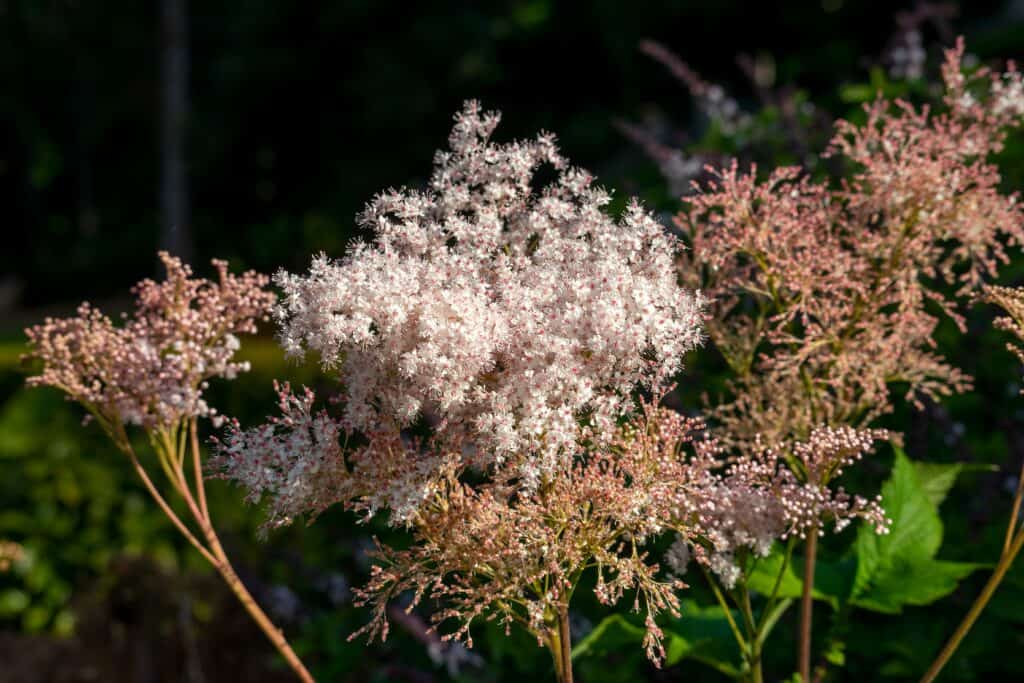
The fuzzy white flowers of meadowsweet attract pollinators.
©Galumphing Galah/Shutterstock.com
Meadowsweet is a great shrub to grow in pollinators or rain gardens. Their small, fuzzy white flowers are attractive to many types of insects especially since they bloom all summer long. At their top height, meadowsweet shrubs only reach around 3 to 4 feet, so they aren’t large plants. You can prune them in the winter months to make them a bit bushier.
Meadowsweet grows best in full sun but it can tolerate partial shade as well. It should be planted in moist soil as it doesn’t tolerate dry conditions well.
9. Viburnum
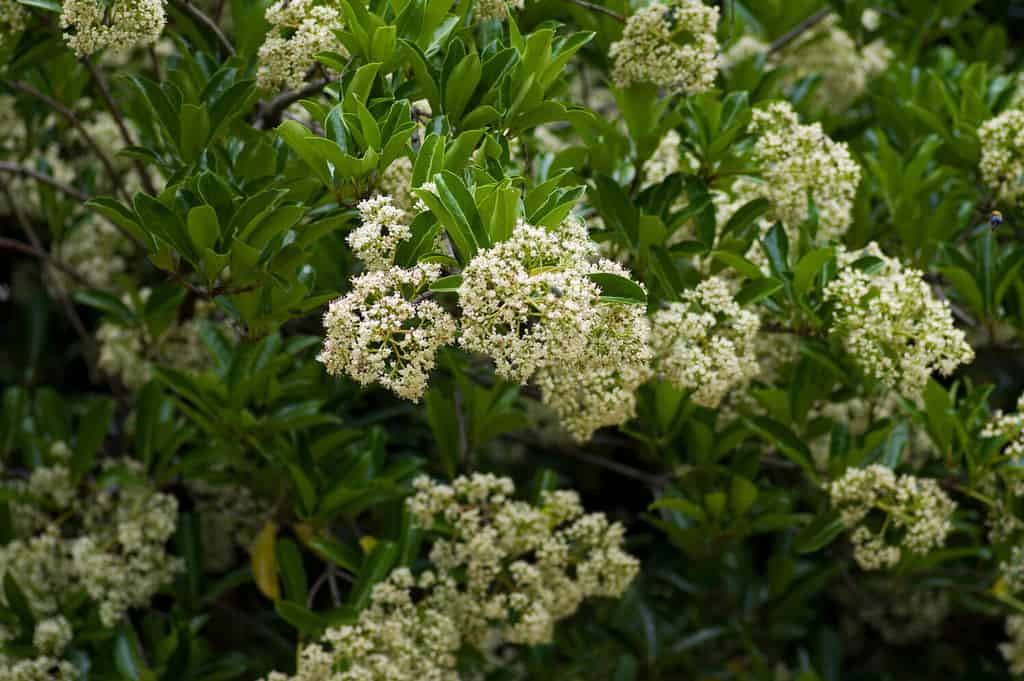
The gorgeous, white flowers that viburnum shrubs produce have a sweet scent.
©zzz555zzz/Shutterstock.com
Viburnum plants are a great shrub to choose if coverage is your goal. They survive in full sun and almost full shade, in almost any soil type, and they grow fast. There are a few different varieties of viburnum that grow to different widths and heights. Choose a cultivar like Viburnum acerifolium for a smaller, bushier shrub. If you’re looking for height you’ll want to pick Viburnum dentatum, which can reach a height of 15 feet, or Viburnum nudum which reaches 12 to 20 feet tall.
One great thing about viburnum bushes is that they produce flowers during the spring and autumn, depending on the species, and fruit during the summer. While viburnum berries are not edible for humans, they serve as a great food source for birds and small mammals. Spring and fall are the best times of year to plant your viburnum shrubs.
10. Common Juniper
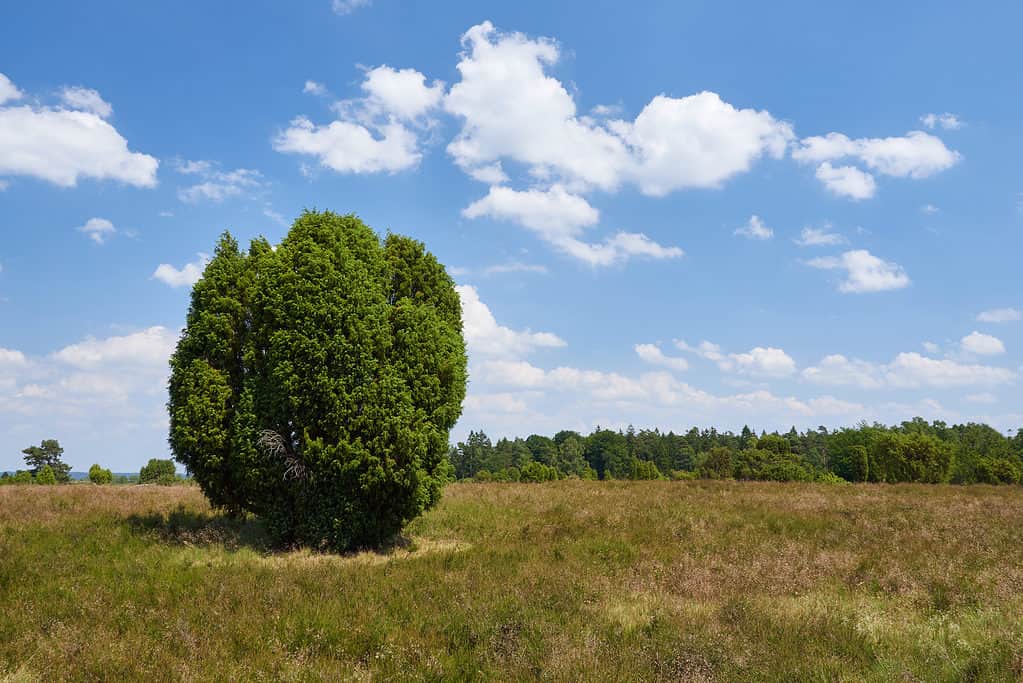
Juniper shrubs produce berries that are used to flavor gin.
©Thomas Marx/Shutterstock.com
Common juniper is one of the most common plants that you’ll find in North America and around the world. It’s a small coniferous evergreen shrub that makes for a beautiful addition to any yard. The plant produces berries during spring and summer which can be used for a few purposes, most notably for adding flavor to gin.
You should plant common juniper in well-drained, medium-moisture soil. It thrives in full sun but will also tolerate semi-shade. You can plant this shrub in early fall or spring for best results.
11. Inkberry

The inkberry plant can be found throughout the United States east coast, including North Carolina where it is native.
©Yingna Cai/Shutterstock.com
Inkberry is a beautiful evergreen shrub that looks great in almost any yard. It thrives in full sun or partial shade and prefers well-drained, sandy soil. It can also tolerate moist and even wet soil on occasion.
Inkberry plants survive through the cold winters well and will retain their leaves as long as temperatures stay above zero. They produce flowers in spring and berries during the winter that are consumed by birds and small mammals. For inkberry plants to produce berries you have to have both male and female plants.
Inkberry shrubs grow to around 5 to 10 feet tall and 5 to 8 feet wide and form colonies by spreading their rhizomes. They make for an excellent hedge because they are bushy and retain their beauty year-round.
Summary of the 11 Best Shrubs To Plant in North Carolina
| # | Shrub | Type of Soil | Sun Preference | Growth Per Year |
|---|---|---|---|---|
| 1 | Azalea | Well-drained, dry soil | Partial shade | 2-10 inches |
| 2 | Hydrangea | Moist soil | Morning sun, afternoon shade | 2 feet |
| 3 | Aaron’s Beard | Well-drained, moist soil | Partial to full sun | 12 inches or less |
| 4 | American Beautyberry | Moist to average soil | Partial sun to shade | 1-2 feet |
| 5 | Carolina Cherry Laurel | Moist, well-drained soil | Full sun | 25 inches or more |
| 6 | Great Laurel | Well-drained, moist soil | Partial sun, afternoon shade | 1-2 feet |
| 7 | Goldenrod | Well-drained, dry to medium soil | Full sun | A few inches |
| 8 | Meadowsweet | Moist soil | Full Sun | A few inches |
| 9 | Viburnum | Any type | Full to no sun | 1 to 2 feet |
| 10 | Common Juniper | Well-drained, medium moisture | Full sun | 4 to 8 inches |
| 11 | Inkberry | Well-drained, drier soil | Full sun to partial shade | 12 inches |
The photo featured at the top of this post is © iStock.com/Maryna Andriichenko
Thank you for reading! Have some feedback for us? Contact the AZ Animals editorial team.






